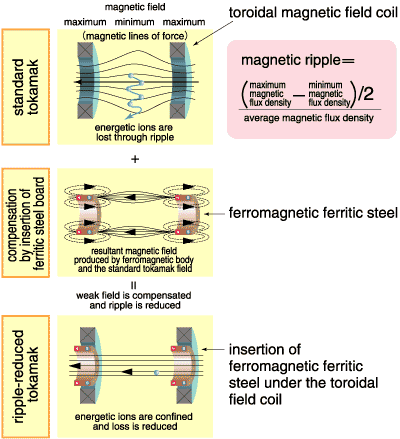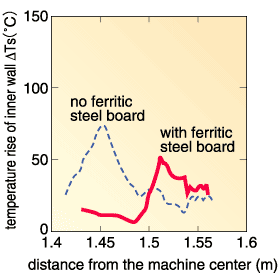Reduction of ripple-induced loss of energetic ions is one of the important issues to be worked out as a solution for the steady-state operation of a tokamak. Ripple is a periodic spatial variation of toroidal magnetic field along the magnetic lines of force resulting from a discrete arrangement of toroidal field coils around the toroidal vacuum vessel. High energy ions trapped in the weak field region are spontaneously lost across the magnetic field (ripple-induced loss).
In a medium-sized tokamak JFT-2M, we have experimentally demonstrated for the first time the reduction of the ripple loss of energetic ions by reducing the toroidal field ripple using ferromagnetic ferritic steel (Fig. 2-8). Ferritic steel boards were inserted between the vacuum vessel and the sixteen toroidal field coils in the JFT-2M plasma as shown in Fig. 2-9, compensating the weak toroidal field between the coils by the superposition of leakage magnetic field from the inserted ferritic boards. The magnetic field ripple was found to be reduced by a factor of about two. To experimentally evaluate the reduction of energetic ion loss, high energy hydrogen ions (36 keV) were injected into JFT-2M and a temperature rise of the inner vacuum vessel wall was measured by an infrared TV and ion probes and others. The temperature rise in a localized area on the wall is due to ion losses and is reasonably assumed to be proportional to the high energy ion flux lost to the wall. The experimental results are shown in Fig. 2-10, which indicate the reduction of the ripple loss by up to about 50%. So far we have not observed any indication of a deleterious effect of the insertion of ferromagnetic ferritic boards on plasma production and plasma control. Since ferritic steel has some advantageous properties as a material for a future fusion reactor such as low radioactivation and good thermal properties and others, we will proceed with our study on JFT-2M to investigate the compatibility of ferritic steel with fusion plasmas. |


